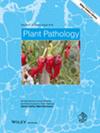Cryptic sexual reproduction in an emerging Eucalyptus shoot and foliar pathogen
IF 2.4
3区 农林科学
Q1 AGRONOMY
引用次数: 0
Abstract
Eucalyptus scab and shoot malformation is an emerging disease and a serious threat to the global plantation forestry industry. The disease appeared in North Sumatra (Indonesia) in the early 2010s and the causal agent was recently described as a novel species, Elsinoe necatrix. Nothing is known regarding its possible origin or why it emerged rapidly to cause a serious local epidemic. To investigate its population biology, we developed 15 polymorphic microsatellite markers as well as mating-type markers using genome sequences for two E. necatrix isolates. Isolates of the pathogen were collected from different host varieties at four locations in the Lake Toba region of North Sumatra and characterized using these markers. A high level of genotypic diversity was observed for all populations with little to no genetic differentiation between sampling areas. Discriminant analysis of principal components, genotype networks and analysis of molecular variance all showed a lack of population structure and a high level of gene flow among sampling regions. Mating-type ratios and linkage disequilibrium analyses suggest that sexual recombination is likely to be occurring, although a sexual state has not been found for the pathogen. The results of this study highlight the fact that new genotypes of E. necatrix, probably arising from cryptic sexual recombination, will challenge efforts to manage the disease, and that breeding and selection for tolerance will require substantial host genetic diversity.

新出现的桉树嫩枝和叶片病原体的隐性有性生殖
桉树疮痂病和嫩枝畸形是一种新出现的病害,对全球人工林产业构成严重威胁。该病害于 2010 年代初出现在北苏门答腊(印度尼西亚),病原体最近被描述为一种新物种 Elsinoe necatrix。关于其可能的起源或为何迅速出现并在当地引起严重流行,目前尚无定论。为了研究其种群生物学特性,我们开发了 15 个多态性微卫星标记,并利用两个 E. necatrix 分离物的基因组序列开发了交配型标记。我们从北苏门答腊岛多巴湖地区四个地点的不同寄主品种中收集了病原体分离物,并利用这些标记对其进行了鉴定。所有种群的基因型多样性都很高,取样地区之间几乎没有遗传差异。主成分判别分析、基因型网络和分子方差分析都表明,采样区域之间缺乏种群结构,基因流动程度较高。交配型比率和连锁不平衡分析表明,虽然尚未发现病原体的有性状态,但有性重组可能正在发生。这项研究的结果突显了一个事实,即可能由隐性基因重组产生的新的 E. necatrix 基因型将对管理该疾病的工作提出挑战,而育种和选择耐受性将需要大量的宿主遗传多样性。
本文章由计算机程序翻译,如有差异,请以英文原文为准。
求助全文
约1分钟内获得全文
求助全文
来源期刊

Plant Pathology
生物-农艺学
CiteScore
5.60
自引率
7.40%
发文量
147
审稿时长
3 months
期刊介绍:
This international journal, owned and edited by the British Society for Plant Pathology, covers all aspects of plant pathology and reaches subscribers in 80 countries. Top quality original research papers and critical reviews from around the world cover: diseases of temperate and tropical plants caused by fungi, bacteria, viruses, phytoplasmas and nematodes; physiological, biochemical, molecular, ecological, genetic and economic aspects of plant pathology; disease epidemiology and modelling; disease appraisal and crop loss assessment; and plant disease control and disease-related crop management.
 求助内容:
求助内容: 应助结果提醒方式:
应助结果提醒方式:


